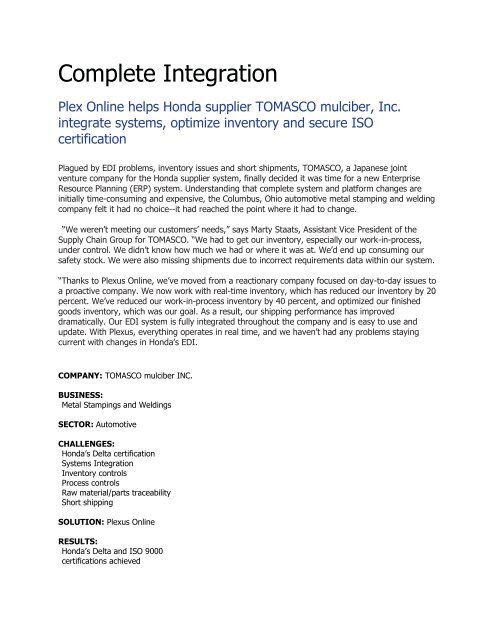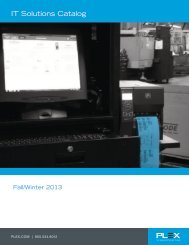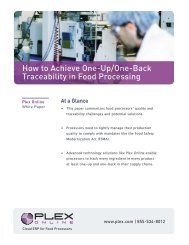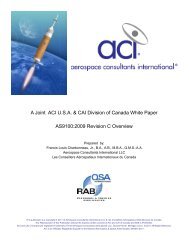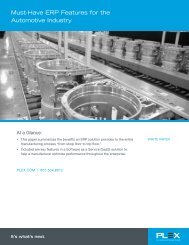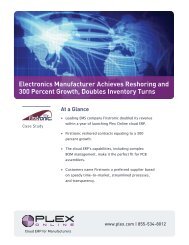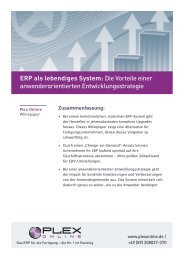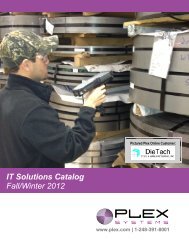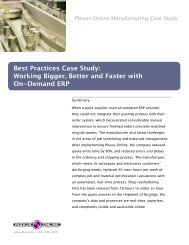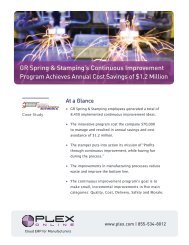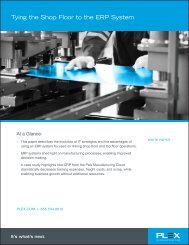Complete Integration - Plex Systems
Complete Integration - Plex Systems
Complete Integration - Plex Systems
Create successful ePaper yourself
Turn your PDF publications into a flip-book with our unique Google optimized e-Paper software.
<strong>Complete</strong> <strong>Integration</strong><br />
<strong>Plex</strong> Online helps Honda supplier TOMASCO mulciber, Inc.<br />
integrate systems, optimize inventory and secure ISO<br />
certification<br />
Plagued by EDI problems, inventory issues and short shipments, TOMASCO, a Japanese joint<br />
venture company for the Honda supplier system, finally decided it was time for a new Enterprise<br />
Resource Planning (ERP) system. Understanding that complete system and platform changes are<br />
initially time-consuming and expensive, the Columbus, Ohio automotive metal stamping and welding<br />
company felt it had no choice--it had reached the point where it had to change.<br />
“We weren’t meeting our customers’ needs,” says Marty Staats, Assistant Vice President of the<br />
Supply Chain Group for TOMASCO. “We had to get our inventory, especially our work-in-process,<br />
under control. We didn’t know how much we had or where it was at. We’d end up consuming our<br />
safety stock. We were also missing shipments due to incorrect requirements data within our system.<br />
“Thanks to <strong>Plex</strong>us Online, we’ve moved from a reactionary company focused on day-to-day issues to<br />
a proactive company. We now work with real-time inventory, which has reduced our inventory by 20<br />
percent. We’ve reduced our work-in-process inventory by 40 percent, and optimized our finished<br />
goods inventory, which was our goal. As a result, our shipping performance has improved<br />
dramatically. Our EDI system is fully integrated throughout the company and is easy to use and<br />
update. With <strong>Plex</strong>us, everything operates in real time, and we haven’t had any problems staying<br />
current with changes in Honda’s EDI.<br />
COMPANY: TOMASCO mulciber INC.<br />
BUSINESS:<br />
Metal Stampings and Weldings<br />
SECTOR: Automotive<br />
CHALLENGES:<br />
Honda’s Delta certification<br />
<strong>Systems</strong> <strong>Integration</strong><br />
Inventory controls<br />
Process controls<br />
Raw material/parts traceability<br />
Short shipping<br />
SOLUTION: <strong>Plex</strong>us Online<br />
RESULTS:<br />
Honda’s Delta and ISO 9000<br />
certifications achieved
An integrated system providing realtime<br />
data to all departments<br />
Inventory reduction of over 20%<br />
Work-In-Process reduction of over 40%<br />
Ability to trace down to a container of<br />
30 parts<br />
100% shipping achieved<br />
We no longer have to wait until the end of the month to see where the problems are--we see<br />
them immediately. We couldn’t have achieved the ISO certification without <strong>Plex</strong>us or met<br />
Honda’s 100 percent traceability requirement. <strong>Plex</strong>us has worked extremely well for us.”<br />
With a mission to find and implement a fully integrated ERP system, TOMASCO began analyzing<br />
its business processes in February 2002. Karen Patterson of the IT consulting firm Revolution<br />
Group was hired to develop a detailed flow chart of systems-based activity and process flows to<br />
pinpoint exactly what TOMASCO should require from a new ERP system. The four-month-long<br />
analysis evaluated 40 separate business processes and identified 131 manual processes, 69<br />
independent databases, 88 duplications of effort, and four interfaced databases. TOMASCO was<br />
using 14 different software products on four different platforms. This type of patchwork system<br />
is typical in manufacturing, but TOMASCO didn’t want to be typical. It wanted to be<br />
state-of-the-art.<br />
By July 2002 TOMASCO had developed an RFQ. Its goal: secure a complete, fully integrated<br />
software system to effectively manage all aspects of TOMASCO business processes. The system<br />
had to be progressive, cost effective and easy to implement. It also had to be certified by<br />
Honda. TOMASCO knew exactly what it needed, but did such a system exist?<br />
Patterson began to search for the ideal software system. She identified 12 prospective vendors<br />
and narrowed them down to three. <strong>Plex</strong>us Online was among the finalists invited to conduct a<br />
two-day demonstration of its software capabilities.<br />
“We were looking for a system that offered complete integration, including EDI, release<br />
accounting, and barcode printing,” Patterson says. “Of course, the vendor had to be a<br />
Honda-approved EDI and barcode software provider, and that proved extremely difficult to find.<br />
We wanted a browser-based system that could be accessed from anywhere since TOMASCO’s<br />
parent company has operations across the globe. The system needed to be multi-lingual,<br />
including Japanese, and offer an exceptional shop floor data collection system, including label<br />
printing on the shop floor. It needed to integrate lot control management from raw materials to<br />
finished goods, for 100 percent traceability. And, the company needed to be positioned to fully<br />
participate in the future of automotive communications.”<br />
<strong>Plex</strong>us was not Honda certified at the time, but it committed to quickly achieving Honda<br />
certification and developing a Japanese language version of its system. In January 2003,<br />
TOMASCO hired <strong>Plex</strong>us Online to integrate its business systems using its modular ERP system.<br />
<strong>Plex</strong>us immediately began its own independent certification process with Honda and became
Honda certified a few months later.<br />
Results seen quickly<br />
“We started in early 2003 with the Parts Building module in the stamping area on the shop<br />
floor,” Patterson says. “It was adopted relatively easily by the shop floor employees. Initially<br />
there was concern that it would take longer to input the data than it would to write it down by<br />
hand, but once the shop employees realized how easy and efficient the system was, they<br />
embraced it.”<br />
The <strong>Plex</strong>us Manufacturing Execution/Shop Floor Control module is a powerful user interface for<br />
shop floor personnel to track and control a work station’s machine status, labor hours,<br />
production, inventory, tooling, etc. Soon after the module’s implementation, TOMASCO found<br />
that its overall equipment effectiveness (OEE) reports were consistent and accurate, eliminating<br />
hours of manual calculations by supervisors. The new system also automated the reporting of<br />
scrap and downtime.<br />
TOMASCO also began implementing the <strong>Plex</strong>us Purchasing, Purchase Receipt and Cycle Count<br />
of Raw Materials modules. At this point there was no effective inventory control for the coil<br />
room. By mid-2003 they had enhanced the communication between purchasing and production<br />
and eliminated the need for a “hot list” and the constant expediting of raw materials.<br />
The next targets were EDI, Shipping and Accounts Receivable. By early 2004 <strong>Plex</strong>us revised the<br />
EDI process and allowed TOMASCO to implement required Honda changes without the need for<br />
internal expertise or involvement. <strong>Plex</strong>us moved TOMASCO to a new platform without any<br />
problems.<br />
Machine Maintenance Goes From Reactive to Predictive, and Quality Scores<br />
Soar<br />
“Before we implemented the <strong>Plex</strong>us Maintenance module, we had improved our quality each year since<br />
2001 by 25.1 percent.” says Ken Keller, Senior Manager, Operations. “We went online with <strong>Plex</strong>us in<br />
March 2005, and our quality improvement jumped to 39.9 percent in a year when we were building parts<br />
for five new model launches, a record for new launches in one year—we usually have two. We could<br />
make these improvements because the information we now have access to allowed us to move from<br />
reactive maintenance to preventive maintenance. Now we’re moving from preventive maintenance to<br />
predictive maintenance.”<br />
Assistant Manager-QMS Deb Reining spent many weeks entering maintenance information and<br />
recommended preventive maintenance for every machine for which she had records. When TOMASCO<br />
went online, every employee could see the repair logs and preventive maintenance performed by<br />
machine. What they saw was that some machines had never been repaired, others broke down<br />
consistently, and still others did not receive the preventive maintenance they needed to optimize usage.<br />
Employees were encouraged to input maintenance requests for machines as soon as they identified the<br />
need, and they did so in droves. By enabling all employees to request maintenance, TOMASCO increased<br />
response time to maintenance requests by 81 percent.<br />
“The EDI capability in <strong>Plex</strong>us is a tremendous asset,” says Patterson. “Honda used a method<br />
called a ‘mailbox’ to send and receive EDI as part of its value added network. In a legacy
system, you have to pull the mailbox, break it down…it takes highly trained, technical people<br />
and dedicated time. With <strong>Plex</strong>us, you no longer have to deal with the technical aspects of EDI.<br />
<strong>Plex</strong>us handles it. They update everything. Honda recently offered suppliers the option of a File<br />
Transfer Protocol (FTP), which <strong>Plex</strong>us implemented. TOMASCO now saves the cost of all the<br />
manhours devoted to EDI, plus it was able to eliminate the IBM’s Value Added Network, saving<br />
thousands of dollars per month. By moving from VAN to FTP, they don’t have to pay for every<br />
transaction.”<br />
The implementation of the Shipping and Accounts Receivable modules in early 2004 eliminated<br />
two major system interfaces, three full time jobs in shipping and one in billing. Customer<br />
release information was immediately available to floor supervisors, removing the traditional<br />
eight-hour communication lag. The real-time customer release information eliminated the need<br />
for a full time position developing and maintaining the information.<br />
The cycle count of finished goods was also brought online in early 2004, eliminating four hours<br />
spent daily counting inventory and communicating to floor supervisors.<br />
Steering hanger beams are one of TOMASCO’s key product lines. TOMASCO implemented the<br />
Quality Management System modules and worked with <strong>Plex</strong>us to enhance the quality check<br />
sheet process used to gather quality information for every steering hanger beam produced.<br />
Each beam has 75 welds, and each of these welds undergoes a quality inspection. Prior to<br />
<strong>Plex</strong>us, the operator would record any issues by hand, but an analysis of issues was not<br />
completed until the end of the month.<br />
In 2004, Reining recorded 4,945.15 maintenance hours. In 2005, after the <strong>Plex</strong>us Preventive<br />
Maintenance module was installed, she recorded 10,469.15 hours. “We used the system to prove we<br />
needed more personnel,” says Reining. “For the first time we could use the equipment control log to<br />
show how many hours were needed to keep every machine in good working condition.”<br />
“Maintenance finally had a clear picture of what was needed and the manpower required,” says Keller.<br />
“We are now able to track the life cycle of key parts, so we can order them in advance instead of having<br />
to expedite them, saving us money and machine downtime. Since we now have established preventive<br />
maintenance requirements, schedules and estimated PM completion timings for each machine, our<br />
Equipment Control Technicians can more efficiently arrange their work around planned machine<br />
downtime such as lunch breaks, shift changes and weekends.”<br />
The <strong>Plex</strong>us Preventive Maintenance module gives TOMASCO the ability to track which machines have the<br />
most problems and what kind of problems they have. When they need new machines, they avoid<br />
purchasing the brands their data shows are troublesome. When quoting new business, the sales<br />
department can quote parts built on machines which historically run the most consistently. This reduces<br />
the potential for repair, expediting, and overtime costs.<br />
“There was great concern that implementing an electronic check sheet at the end of these<br />
production lines would have a negative impact on overall production and lower productivity,”<br />
explains Patterson. “We didn’t know if a person could use the computer screen to enter the<br />
data on 75 welds before the next beam came down the line. But these fears were proven<br />
false. TOMASCO now had a method to collect and analyze quality information immediately and<br />
began a procedure to check the information during the day. This allowed maintenance<br />
associates to make adjustments to the equipment during operator breaks and lunch times,<br />
correcting weld issues so that good parts could be produced consistently. This virtually
eliminated the backlog of rework parts and significantly improved productivity in the weld area.”<br />
Because quality check sheets can be tied directly to serial numbers shipped to the customer,<br />
quality issues can be more easily contained and analyzed. This was a big win for TOMASCO with<br />
Honda.<br />
“The 100 percent traceability capability is critical,” says Ken Keller, Senior Manager, Operations.<br />
“<strong>Plex</strong>us allows us to trace back to a particular coil of steel or a container of 30 parts. The ability<br />
to trace materials with such accuracy has allowed us to reduce our financial exposure should a<br />
product issue occur. The quality of the information has also allowed us to significantly improve<br />
business processes throughout the plant.<br />
“In the past, we typically handled two new model launches a year. In 2005, we handled five.<br />
We couldn’t have done this without <strong>Plex</strong>us.”<br />
The detailed information now available through <strong>Plex</strong>us provides the new product development group with<br />
an improved history of failure modes. They are using this info to develop the FMEAs and to design and<br />
process potential problems out of individual parts.<br />
“We can trace back to each machine used to produce each part and the exact time the part was made,”<br />
Keller explains. “We track all maintenance and changes for every machine, when they were made, and by<br />
whom. This type of machine history could save us millions if there was ever a safety issue or a product<br />
recall. Before <strong>Plex</strong>us, we didn’t have the concrete evidence to pinpoint the exact changes. In a recall<br />
situation, we would have had to recall every piece. Now, if we were ever to find ourselves in that<br />
situation, we would only have to recall to the point where a proven change in the process occurred.”<br />
“In a recall situation, a lack of traceability would bring a supplier to its knees,” says Karen Patterson of<br />
Revolution Group, an Ohio-based IT Consulting Firm. “Being able to isolate this information can be very<br />
difficult without the right system.<br />
“The Preventive Maintenance module is a piece of the <strong>Plex</strong>us puzzle that can be installed as a stand alone<br />
system. Adopting an entire ERP system might be too much for some companies to handle, but the<br />
Preventive Maintenance module is one chunk with huge impact. You need well maintained machines to<br />
make consistently good parts.”<br />
ISO Certification a Natural Byproduct<br />
“We first started working towards our ISO certification in the mid-90s,’” says Assistant<br />
Manager-QMS Deb Reining. “There was one issue after another. We were convinced we<br />
needed to go to another system platform.<br />
“When <strong>Plex</strong>us did its demo, they supported our idea that you had to rewrite our entire system.<br />
<strong>Plex</strong>us told us that if we used its system correctly, there was no way we could not get certified.<br />
Before we started with the Document Control module, it could take weeks to get signatures on<br />
process changes. With the <strong>Plex</strong>us module, they are e-mailed. And you get an e-mail every day<br />
until you approve it.<br />
“We started with check sheets in Stamping. We used to write everything by hand and check<br />
the sheets four times a day. When we started entering everything online through <strong>Plex</strong>us, we
had the ability to check for any changes before running the line. We now can have SPC on all<br />
the lines. We were actually meeting ISO procedure requirements without realizing it.”<br />
The QMS group also implemented the Audit and Training modules, which work together to put<br />
information required for ISO certification at their fingertips.<br />
“The Document Controller issues a training sheet every time any procedures or work<br />
instructions are updated or changed,” Reining emphasizes. “We can track it to an individual.<br />
The Audit module allows us to schedule audits, maintain audit results, add notes, etc. We used<br />
the Internal Audit module to secure both ISO 9000 certification and the ISO Environmental<br />
14001 certification in 2004. The environmental certification is very important to Honda.”<br />
TOMASCO continues to streamline its business systems as it progresses further along its ERP<br />
module implementation.<br />
“We can now see costs as they occur, and we don’t have to wait until the end of the month to<br />
see where our problems are,” says Staats. “We have a better understanding of our parts<br />
structure, which helps with costing. Everything integrates. We spend considerably less time<br />
managing data, and we’ve resolved a majority of our inventory issues. We are able to meet the<br />
needs and demands of our customers, and we are well positioned for the future.<br />
“If a company implements <strong>Plex</strong>us Online and uses all of its functionality, it can’t help but<br />
become a great company.”


